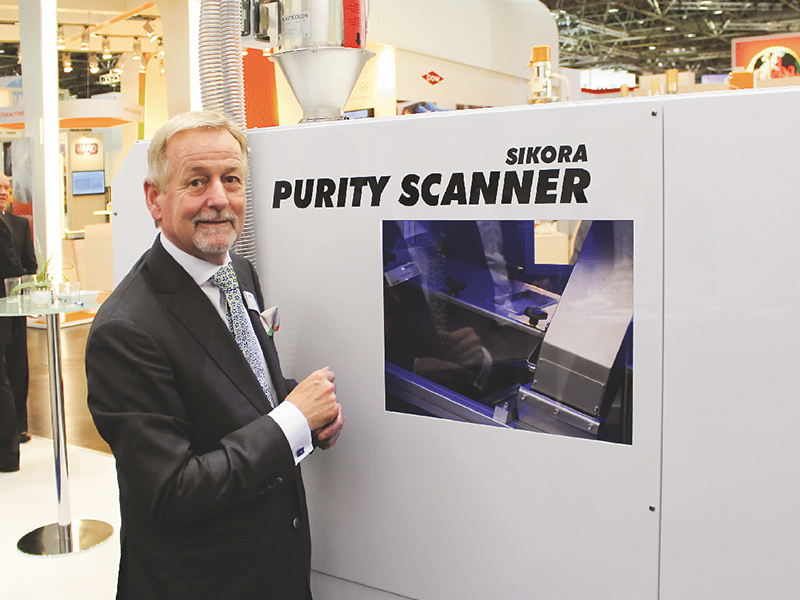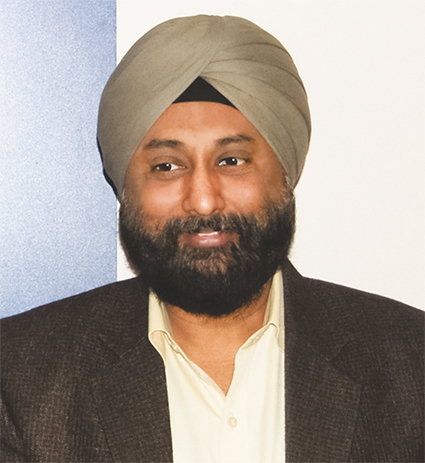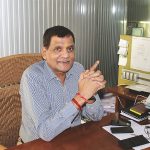A new system for the detection and sorting of contaminations in plastic pellets
Founded in 1973, Sikora AG celebrated its 40th anniversary last year. It is currently a leading global manufacturer and supplier of measuring and control technology for the wire and cable, hose and tube as well as optical fibre and plastic industry. With 200 employees worldwide, 13 offices and more than 30 regional representatives all over the world, the company provides customers with innovative product solutions and individual service.
The company’s measuring and control systems are exclusively made at its headquarters in Bremen, Germany.
During Wire Dusseldorf show the Wire & Cable India team interviewed Mr. Harry Prunk, CEO, Sikora AG, about the new technologies that his company has developed in the recent past. Mr. Premjeet Saggu, Director, Sikora India, also highlighted some of the special features of Sikora’s new technologies.
Here are some excerpts from this highly informative interaction.

New Technologies
A couple of years ago, Maillefer raised important questions about the possibilities of the development of a system for the detection and sorting of contaminations in plastic pellets. The reason for the need of such a system was – and continues to be – the continuously increasing demand for renewable energies on the international energy market. The worldwide installed capacity has increased from 1,250 GW in 2010 to 1,700 GW in 2013. A part of this is supplied by wind turbines in offshore wind farms. For the power transmission to the mainland, submarine cables are used, which have to fulfill sophisticated requirements due to the specific environmental conditions. As a result, the cable structure and its production process have to follow national and international standards. In these regards, the purity of the XLPE compound plays a critical role, especially with regard to the insulation – the purer the compound, the lower the risk of a breakdown.
An important aspect is the cable joint, specifically in the context of high voltage cables for offshore applications. The joints where the cables are welded together are always critical. Energy suppliers therefore want cable manufacturers to deliver large cable lengths with a minimum amount of joints, as each joint contains a potential risk for breakdowns. So, the aim is to produce energy cables with long lengths with only a few joints while using highly pure raw material.
To catch possible impurities in the XLPE compound before they get into the cable, cable manufacturers use screens that are positioned directly in the melt flow after the extruder, before the crosshead and, thus, prevent the contaminations from entering the product. But these screens can get clogged by degraded XLPE, that is, scorches, or excessive amount of contaminants after certain run time, and then the melt pressure in the extruder may increase significantly. Finally, the production has to be stopped in order to change the screens, which in turn means that later a joint is required at that position.
An approach to increasing productivity is to omit the screens. This requires, however, appropriate methods to detect and sort out contaminations in the XLPE pellets at an early stage.
A solution to this problem is a system that inspects the pellets for purity before the XLPE pellets get into the extrusion process. Currently installed devices use optical measuring principles that randomly inspect pellets for contaminations. Since this is a sample check only, not 100 per cent of the material is controlled. Besides, with optics, only the outside of the pellet can be inspected, while impurities inside the pellets remain undetected. Besides, the inspection of the raw material with existing devices is not done under clean room conditions, so that new impurities can emerge from the ambient air or as a result of the conveyor belt used.
For Maillefer, it was important to develop a system that inspected 100 per cent of the XLPE pellets and that sorted out reject material reliably. In initial experiments, various sensors were tested in order to ensure a reliable detection of contaminations with a size of 50 µm. Soon it became clear that Sikora had the know-how to develop the appropriate technology to meet Maillefer’s requirements. With the newly developed Purity Scanner, metallic and organic contaminations not only on the surface but also inside the pellet can be detected. The system applies for XLPE compounds as they are used at the production of medium, high and extra-high voltage cables, as well as underground and submarine cables, including semi-conductive XLPE compound.
With a combination of X-ray and optical technologies, a system was developed that inspects 100 per cent of the pellets for purity before they enter the production process. Rejected XLPE pellets are sorted out reliably. The transport of the pellets is carried out through a vibrating ramp. This transport system is hermetically sealed with the result that no external impurities get into the material flow. With this system, the quality and consequently the reliability of the end products in the high voltage cable industry can significantly be increased. This also improves the safety and usability for the end user.
Speaking about the new technologies recently developed at Sikora, Mr. Prunk said, “New developments at Sikora are largely in the range of high voltage cables. Although we have developed quite a few new products, what we have been talking about the most is our Purity Scanner. It is a device that can be specifically used for medium, high and extra-high voltage cables. And what we have is a system that can inspect the pellets that are used for the manufacture of medium, high and extra-high voltage cables as well as for offshore cables. The idea is to inspect the pellets before they go into the extruder. If you check on the market, you will see that there are already some devices available for this kind of application. But all of these devices work on an optical basis. The problem with a pellet is that it is white. It’s easier to see contaminants with the help of an optical system if they are on the surface of the pellet, but what you cannot see is the inside of the pellet. It’s possible to check for dots on the outside of a pellet, but if there is anything inside the pellet, it cannot be seen by any optical device. So the challenge was to develop a system that can not only inspect the outside, but also the inside of the pellet. And mind you, we are looking specifically for metallic contaminants in the size of 50 µm. Your hair has a thickness of 50 µm. Cut something as long as the thickness of it – it’s almost not visible. But for high voltage cable, it is critical. For that reason it needs to be detected. Today, when high voltage cable manufacturers buy high voltage material, they pay a lot of money to get extra-clean material. But that extra-clean material is checked only for a certain percentage, which is less than 1 per cent. So, statistically it is clean. But real cleanliness is something you can check when you put the material down into the extruder because only then you catch also those contaminations that are added in the transport and handling. So what did we do? We developed a system that was a combination of X-ray – to check what was inside the pellet – and an optical system – to detect the contaminants on the outside. X-ray cannot detect the colour of the pellet. But it can see even the tiniest contaminant of metal or organic material inside the pellet. To detect colour changes, we need an additional optical system. That was the basic idea. This system is designed for a throughput of 500 kg., which is currently needed in CV lines. Devices for a higher throughput are available for plastic manufacturers.
“The next important difference is that the typical systems that are available today did not start in wire and cable industry; they may have started in the food-sorting sector, like sorting of rice or peanuts. They typically use a conveyer belt – like the one used at supermarkets and airports. If you look at a conveyer belt, you’ll notice that the edges of the belt are worn out. And that means that a conveyor belt brings additional contaminants into the polymers. So we designed a stainless steel ram that vibrates. All of the pellets run in one layer – a carpet of pellets. The tray containing the pellets has an X-ray system, which is placed at the top. We carefully observe all the pellets, checking what’s inside them. Then these pellets fall down and while they are falling, we have two optic cameras that check them from the outside. Below that we have 21 nozzles. The contaminated pellets are rejected with air or nitrogen. And we get only the clean material into the extruder. No contaminants get added.
“This is for the moment something unique and interesting not only for cable manufacturers, but also for all compound manufacturers. When a contaminated pellet is rejected, a few clean ones also get rejected, but that doesn’t matter considering the amount of material being inspected.
“One more benefit of our system is that the transport shell where these pellets go is completely sealed, so one doesn’t need a clean room around it. As you know, a clean room is rather expensive to maintain. So, in our system, all of the material flow is completely sealed and even there’s a slight over-pressure, no air can get to the pellets from outside. Other systems on the market are very open and need to be operated in a clean room . And here we provide a 100 per cent inspection of the pellets.
“It is for the first time that such a system has been brought to the market. The driver for this development has been Maillifer. They had experience with other systems and found that using a conveyor belt led to addition of extra dirt.”
Highlighting the advantage that the Sikora system offers to the customer, Mr. Saggu said, “One major advantage that Sikora has is that, to disallow the contaminants to go into the extruder, a fine mesh is used.”
“Typically, you have the mesh between the extruder and the crosshead. This mesh should collect all the contaminants. But the difficulty is that these meshes get clogged over time. So the pressure in the extruder gets higher and higher and then one day you have to stop the line. Stopping the line and replacing the mesh is not expensive. What proves costly is stopping the line. The production downtime could be 10 to 15 hours. So, the current discussions are towards leaving these meshes out,” added Mr. Prunk.
Speaking about a new type of preheater that Sikora currently offers, Mr. Prunk said, “Sikora has also developed a new type of preheater. At the manufacture of cables – specifically automotive and data cables – a reliable conductor preheating is required to ensure optimum adhesion and controlled foaming of the insulation on the wire and the data cable. With this preheater, we offer an advanced solution for a precise conductor preheating – the basis for high-quality cable production. Unique is the measurement of the wire temperature inside the preheater by a non-contact infrared camera and its direct feedback to the power control, for a precise control of the preheating power. The preheater is positioned before the extruder and preheats the wire by means of inductive heating depending on the product type up to 150°C. For several decades we just went for preheating; and now we know the temperature because it’s measured and controlled. “
Adding a footnote to the product description given by Mr. Prunk, Mr. Saggu, said, “This feature is important because if, let’s say, a Delhi-based company is manufacturing cables during daytime, when the temperature is 42°C and it rains and by evening the temperature drops to around 28°C, there is a huge difference in the ambient temperature, which may result in additional problems with the insulation. So that’s where this system plays an important role. It gives the customer a 100 per cent okay product.”
“The ingoing wire may not necessarily be of the same temperature. In the morning, the temperature can be around 20°C and may rise to 40°C by afternoon. But the power of the preheater is always the same if no temperature measurement is used,” added Mr. Prunk.
Importance of Inspection
Commenting on the importance of pellet inspection, Mr. Prunk said, “Today the risk that one would have from any discharge is extremely high. Cost can easily go up. Some years ago we were talking about 110 KV cables: the electrical stress was not very high. Today we are talking about cables in the range of 400-500 KV. So the stress is much greater. Something needs to be done. In addition, we have offshore cables that run for kilometers in the seas. If for those cables the mesh is left out, it is possible to run a longer length, meaning to produce cable with less joints. This drastically reduces the cost and the risk, as joints are expensive and always a potential source of a damage. Because if something breaks there, then to bring the cable up again and fix it is rather expensive.
“You also want to have a continuous run for as many days as possible. So, typically, what you want to do is that you want to make sure that the material that goes into the extruder is clean. The next thing you want to do is that you want to make sure that the temperature of the polymer melt is correct. And Sikora has invented an ultrasonic-based temperature measuring system to make sure that the temperature of the melt doesn’t go too high. If it goes too high, then you have a problem that causes scorches and ambers. If it goes too low, it may not have the right viscosity. To ensure the right viscosity and temperature, we have these ultrasonic-based temperature measuring systems – the so-called Ultratemp. And then we have an addition CSS2, which is an optical system to check the polymer melt – and that would see if there are any contaminants added from the extruder. So, we basically have a real combination of equipment for quality assurance – all meant to avoid the discharges that can cost our customers a lot of money.”
Equipment Installed
Sikora has recently installed its devices in three wire and cable companies. “We have sold three of our inspection devices so far. One of them was installed at Maillefer in April. We have supplied a device to Greece – to the company Fulgor. This company has made a huge investment in the production of offshore cables. The third one has been delivered to a German company. This company is in the medium and high-voltage business,” said Mr. Prunk.





